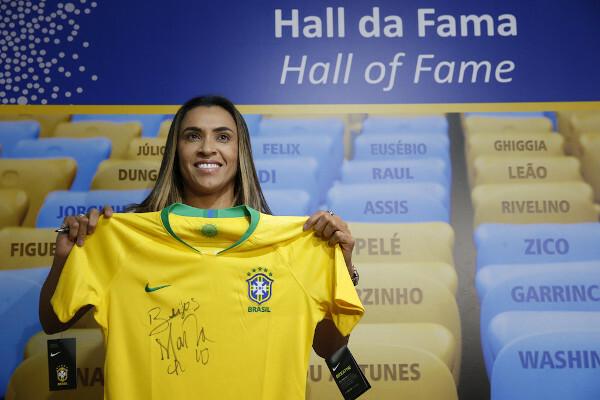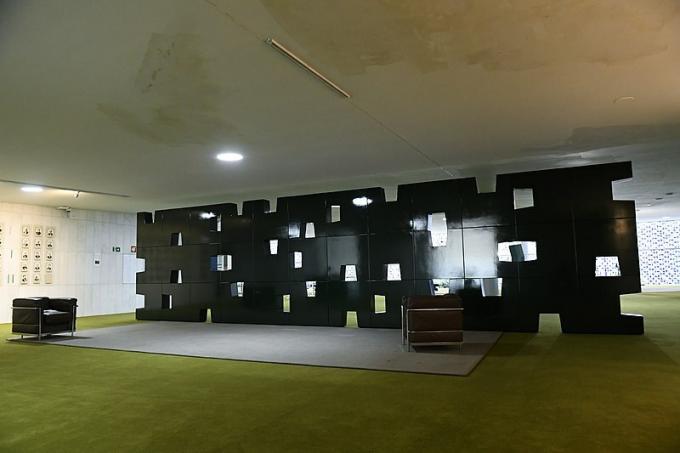A Women's World Cup is an international women's football competition organized by the International Football Federation (FIFA). The world championship takes place every four years, as does the men's version.
The first official version of the Women's World Cup recognized and held by FIFA was in 1991, in China. In the year in question, the selection of the United States emerged victorious.
In 2023, the ninth edition of the Women's Cup will take place. This time, two countries will host the event: Australia and New Zealand. The edition will be held in July.
Read too: Copa das Americas — the world's oldest competition between football teams
Topics of this article
- 1 - History of the Women's World Cup
- 2 - 2023 Women's World Cup
- 3 - Women's football in Brazil
- 4 - Women's football in the world and the role of FIFA
History of the Women's World Cup
In 1970, the International Federation of Women's Football — in Italian, Federazione Internazionale Europea Football Femminile (FIEFF) — organized the first major women's football championship at international level, the Coppa del Mondo, in Italy.
internationally, the event is known as the first unofficial women's football cup. The event was sponsored by the drinks company Martini & Rossi. The sponsors held a second edition of the championship, this time in 1971, in Mexico. The cup gathered 10 thousand spectators.
In 1991, the first official version of the Women's World Cup was held by FIFA,in China. The United States beat Norway 2-1, in a match that took place in the city of Canton (Guangzhou).
Do not stop now... There's more after the publicity ;)
In the first edition, only 12 teams participated in the world championship. In 1999, the number rose to 16, changing in 2015, when 24 countries participated in the championship. The 2023 edition will mark the largest number of participating countries: 32 in all.
Check below the table with host countries and winners of each edition.
Edition |
First place |
Second place |
Host country |
1991 |
U.S |
Norway |
China |
1995 |
Norway |
Germany |
Sweden |
1999 |
U.S |
China |
U.S |
2003 |
Germany |
Sweden |
U.S |
2007 |
Germany |
Brazil |
China |
2011 |
Japan |
U.S |
Germany |
2015 |
U.S |
Japan |
Canada |
2019 |
U.S |
Netherlands |
France |
In the first edition of the Women's World Cup, held in China in 1991, the games lasted 80 minutes and not 90, as it was believed that women would wear themselves out in 90-minute games. From the second edition, held in Sweden in 1995, the games became 90 minutes long..
After the success of the first women's soccer tournament, held in Atlanta, United States, in 1996, the United States was chosen to host the Women's World Cup in 1999. After the tournament, the public's interest in women's games increased in the country, bringing about 37,000 spectators to the women's games. In the final of the 1999 cup, 90,000 people watched the game that gave victory to the United States.
In 2003, the United States hosted the Women's World Cup again. China was supposed to be the host, but it was unable to host in the year in question due to an epidemic of severe acute respiratory syndrome (SARS). For that reason, automatically, she became the hostess of the year 2007.
After that, they also hosted Germany, in 2011, Canada, in 2015, and France, in 2019. In 2023, two countries will host the Women's World Cup: Australia and New Zealand.
![Players of the Brazilian National Team who participated in the Women's World Cup in 1995, along with the team's coaching staff. [2]](/f/2a4c48da399d81b34368f30328ebc3e3.jpg)
The Brazilian Women's Football Team participated in all editions of the Women's World Cup. In the year 1999, she ranked third. In the year 2007, it was in second place, losing in the final 2-0 to Germany.
2023 Women's World Cup
![2023 Women's World Cup logo. [3]](/f/bb76aba604f781f775cc7a9cb4856e9d.jpg)
For the first time, the 2023 Women's World Cup will be held in two countries: Australia and New Zealand. The world championship will start on July 20th and end on August 20th.
In addition to the two host countries, the 2023 edition will bring another milestone: the participation of 32 teams competing for the world title. The brand represents the largest number of participants in a Women's Football World Cup.
Another novelty is that, in this edition, FIFA held play-offs for three places in the World Cup. The repechage games took place between January 17th and 23rd, in New Zealand. The vacancies were occupied by Haiti, Panama and Portugal.
The tournament will feature two teams from Asia (China Taipei and Thailand), two from Africa (Senegal and Cameroon), two from South America (Paraguay and Chile) and one from Oceania (Papua New Guinea). In addition, there will be two teams from the Football Confederation of North, Central America and the Caribbean (Concaf), they will be Haiti and Panama.
Check out the 2023 Women's World Cup group breakdown below:
2023 FIFA Women's World Cup Group Division | |||
|
A group New Zealand Norway Switzerland Philippines |
Group B Canada Nigeria Australia Ireland |
Group C Japan Croatia Spain Zambia |
Group D England China Denmark Haiti |
|
Group E U.S Netherlands Vietnam Portugal |
Group F France Brazil Jamaica Panama |
Group G Sweden South Africa Italy Argentina |
Group H Germany Colombia South Korea Morocco |
Belonging to the F group, Brazil's first game will be on July 24. The opponent was defined in the repechage and will be Panama.
Women's soccer in Brazil

Women's football in Brazil It is a very recent right in the history of our country., as well as others, such as the right to regulated work, to vote and to divorce.
If, in 1932, the then president Getúlio Vargas took a big step by enacting the right to vote for women, in 1941 Vargas set back women's rights when he banned the practice of women's football in Brazil. At the time, Decree-Law No. 3,199 prevented women from practicing sports, considering soccer restricted to men. Article number 54 had the following statement:
Women will not be allowed to practice sports that are incompatible with the conditions of their nature, and must for this purpose, the National Sports Council issues the necessary instructions to the sports entities of the country.
Women were barred from sports for 40 years, when, in 1982, the athlete Rose from Rio, with players from São Paulo and Corinthians, organized a women's soccer match at Estádio do Morumbi.
To circumvent the ban, the event took place during the 1st National Festival of Women in the Arts and was publicized as a preliminary event with a charitable character. The match was the milestone for the decriminalization of women's football, even during the Military Dictatorship, in 1983.
Despite the then legality of the female modality of the sport, in its early years, women's football suffered prejudice and lack of investment. In the 1999 World Cup, for example, the team did not have its own uniform, being forced to use the remaining uniforms of the men's team.
The Vargas Era decree, prejudice and machismo were the main damages to the professionalization of women's football in Brazil. Despite the difficulties and barriers, Brazilian women's football has a series of records and great marks for world football. Most of these marks were beaten by Marta, one of the greatest scorers of all time.

The considered Queen of Soccer has two gold medals in Pan American Games (2003 and 2007) and six Golden Balls (2006, 2007, 2008, 2009, 2010 and 2018). By way of comparison, the only number 10 who matched Marta in Ballon d'Or numbers was Lionel Messi.
See too: Pelé — the greatest player in football history
Women's football in the world and the role of FIFA
There is no doubt that there is a big difference in investment between men's and women's football, felt in the public, in the number of sponsors and in the conditions of exercising the profession of athlete in each gender.
Unfortunately, the situation goes beyond Brazil, being felt by several other countries, especially the emerging and poor ones. Aiming at equity between football modalities, FIFA created, in 2018, the Women's Football Strategy program.
The initiative works with confederations, association members, clubs, players, press and football fans in taking concrete actions for female empowerment and the fight against sexism within football.
The Strategy allocates financial resources and actions to women's football. One of the possible consequences of the program is the record of spectators of the World Cup in France, in 2019, which reached more than a billion people in 205 countries. The 2019 World Cup final was the most watched of all time, with an audience of 263.3 million people (per broadcast).
image credits
[1] Romain Biard / Shutterstock
[2] Football Museum / Wikimedia Commons (reproduction)
[3] Jeevandhika / Shutterstock
[4] Salty View / Shutterstock
[5] take radian / Shutterstock
By Miguel Souza
Journalist
Meet Marina Aggio (41), from Paraná who played for the Brazilian national team and now works as a Physical Education teacher and researcher on women's football
Find out how the idea of creating the Copa América came about, in addition to knowing the names and main characters of the main club competition in South America.
Click here to find out more about the Copa Sudamericana football. Know the history and how this championship works. See who the champions are.
Click on this Brasil Escola link and access information about the World Cup, held every four years by the International Football Federation, FIFA. See in the text essential information about the competition, how the first World Cup was organized and check out some basic statistics.
The 2023 Women's World Cup will start on Thursday (20) in Australia and New Zealand. Check out Brazil's games in the World Cup and the athletes called up.
Get to know the main curiosities about national and world football and also learn the meaning of the different terms and expressions of this sport.
History, curiosities and current situation of soccer in Brazil.
Know the history of football. See how it came about and its arrival in Brazil. Find out how the World Cup came about, what were the first stadiums and much more!
Read a brief biography of Pelé, the greatest football player of all time. Get to know the clubs where Pelé played and the main titles he won.

